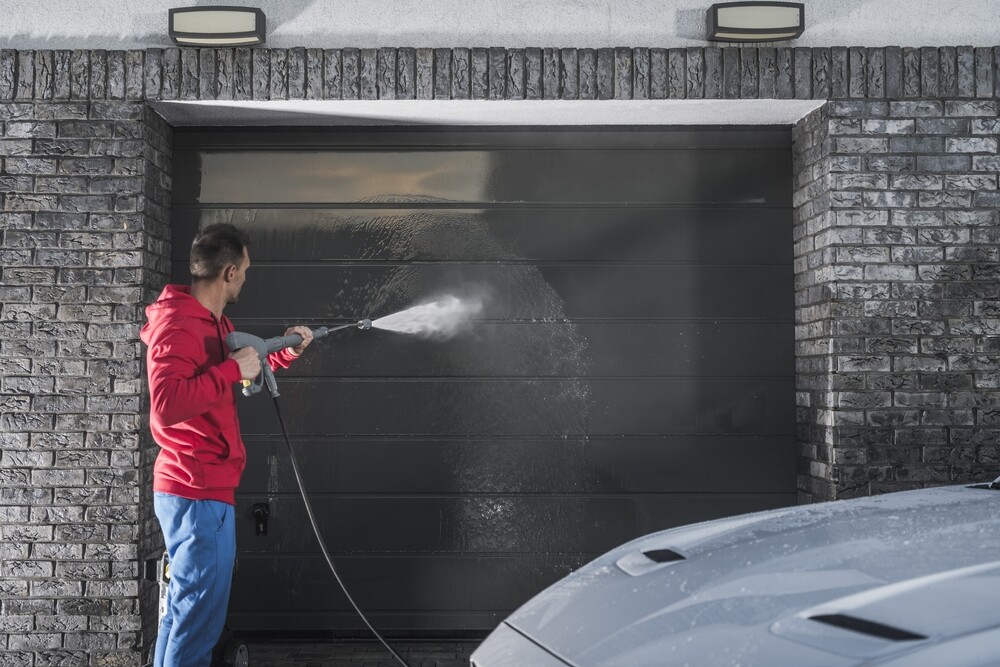You want your garage door to have a long life and work properly through the years, don’t you? If so, then it is important you consider routine garage door maintenance. Fortunately, we’ve got your ultimate garage door maintenance guide right here. We’re going to cover all the best, most vetted maintenance and upkeep tips, no matter your garage door type.
Here’s a question for you. What’s the largest moving object in the typical home? If you guessed a garage door, you’re right. And as the largest moving object in your home, your garage door requires a certain level of care and maintenance to ensure it functions properly through its life cycle. Because, let’s face it, your garage door gets heavy use, has a lot of moving parts, and can be expensive to replace. In fact, depending on your market, a basic 16- x 7-ft. non-insulated door with installation runs about $2,000, and an insulated door the same size is around $2,400.
That’s not an insignificant amount of money. At those prices, you need to make sure you do everything you can to keep your garage door in its best shape. So, without further delay, let’s dive into your ultimate garage door maintenance guide.
1. Use Only When Needed
Just consider for a moment the number of times your garage door opens and closes in one month. According to most common sources, the average garage door opens and closes 3 to 5 times per day. That represents over 1,500 times per year. So, if you are maxing that out at 5 times per day, your garage door will only last around 5 to 7 years, which is a short period of time for a garage door. To help mitigate excessive wear and tear of this nature, try only going in and out of the garage when absolutely necessary. If possible, use your front door to enter and exit your home. This simple act will extend the life of your garage door and prevent a costly replacement in the future.
2. Look, Listen, and Test
One of the easiest and most important preventive garage door maintenance steps you can take is to observe your garage door in action every time you use it. Take a moment to simply observe its motion and look for any grinding or scraping noises. You also want to pay close attention to its movement. Does it operate smoothly or does it open and close in a jerky fashion? Do both sides of the system (springs, pulleys, and cables) look symmetrical? If your garage door is not properly balanced, the garage door opener will have to work harder, and you will find yourself replacing it prematurely.
The best way to test your garage door is to manually open and close it. After you disconnect the opener by pulling the release handle (usually a red cord), manually move the door about halfway up. If it doesn’t stay put, the counterweight system (springs) is improperly balanced. Remember, do not try to fix an improperly balanced garage door yourself. This is something better left to the professionals.
3. Plan for Annual Inspections
While it is important that you pay close attention to how your garage door sounds and behaves, it is still important to ensure you have a professional come out to conduct an annual inspection. Think about it as though it were your car. You certainly would not put off an oil change far longer than you are supposed to. Your garage door should be viewed in the same way. It doesn’t hurt to have a licensed garage door repair professional come out once a year to examine your garage door and all of its associated parts and components. It’s not expensive and will save you in the long run if something is discovered that results in a damaged or destroyed garage door.
4. Clear, Tighten, and Lubricate
You don’t have to call a garage door repair person to clean up critical sections of your garage door system. For example, you’ll want to remove rust and debris from the tracks on both sides of the garage door. Also take a moment to check the brackets holding the tracks to the wall and ceiling, as well as the fasteners securing the garage door opener unit. Door vibration can loosen your garage door hardware, so use a socket wrench to tighten any loose
Finally, ensure your garage door, tracks, and rollers are all properly lubricated. Ensuring proper lubrication reduces friction and overall stress on the entire system. We recommend that twice a year, you apply a spray lubricant on the rollers and hinges, then wipe off any excess. Why? Because dust collects and builds up on parts, which creates noise and friction. Go with the original WD-40 formula to lubricate your garage door components while breaking up grease and dirt.
5. Test the Safety Features
Your garage door and associated components come with safety features built-in. It is important that you check these safety features once or twice per year. Start by testing your garage door opener’s auto-reverse feature. This safety feature forces the garage door to quickly reverse if it detects an obstacle, like a car, animal, or child. It’s activated by a pressure sensor or infrared photocells or lasers on each side of the door.
There are separate ways to test the mechanical and photocell features. To test the mechanical feature, place a piece of wood or a brick on the ground in the path of the door. When the door coming down touches that object, it should reverse direction and go back up again. To test the photocell or laser, close your door and just pass your leg in the door’s path. The door should immediately reverse course once your leg interrupts the photocell or laser beam.
Also, test your garage door opener’s emergency stop function. All you need to do is either close or open the garage door and while it is in motion pull the emergency cord. The door should immediately disconnect from the opener and fall down.
5. Replace Weatherstripping and Check Insulation
If there is one element of your garage door that will degrade over time and require your close attention, it is your garage door’s weatherstripping. If the rubber weather seal strip on the bottom of your door is brittle or cracked, replace it right away. With winter here, the last thing you want is cold air seeping into your garage. Weatherstripping is sold by the foot at hardware and home improvement stores. Just cut it to size and insert it into the grooves with the wide angle of the flange inside the door. It really is that easy.
If your garage door is insulated, double-check your insulation panels to ensure they are not damaged or degraded. It is their job to ensure your garage door stays at a comfortable temperature, so take a moment out to ensure they are still in tip-top shape.
6. Repair, Clean, and Paint
Does your garage door have dents or damage? Have you been meaning to replace it but just have not gotten around to it? Consider steps that you can take yourself to beautify your garage door and ensure it remains both aesthetically pleasing and functional.
Closely examine the door itself. Wood doors will need to be checked for water damage and warping, as well as chipped and peeling paint. Steel doors may have rust spots that need to be sanded, primed, and painted. Wash your garage door regularly with a mild all-purpose cleaner at the same time you do your car.
We hope you’ve enjoyed our deep dive into garage door maintenance. This ultimate guide should help you ensure your garage door has a long and healthy life in your home. In the meantime, should you need expert garage door repair professional help, simply get in touch with your friends at Prestige Door!

